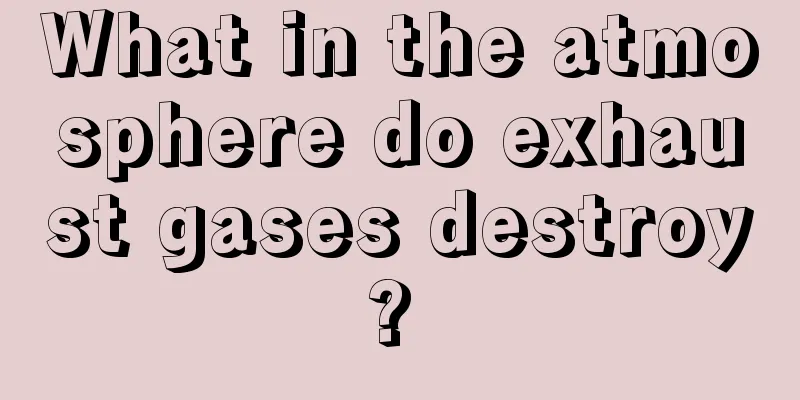What in the atmosphere do exhaust gases destroy?

|
Waste gas is produced everywhere in life. For example, the gas people breathe is waste gas. Especially now that the number of cars is increasing, the amount of waste gas emitted from car exhaust is relatively large. In addition, a large amount of waste gas is often produced in industrial production. These waste gases will not only directly endanger human health, but also directly damage the atmosphere. So what specifically does the waste gas destroy in the atmosphere? What in the atmosphere do exhaust gases destroy? Greenhouse effect: Due to excessive burning of fossil fuels by humans, the concentration of greenhouse gases such as carbon dioxide and methane in the atmosphere is much higher than before. The characteristic of greenhouse gases is that they allow short-wave sunlight to pass through, but block the long-wave thermal radiation of the earth. As a result, the temperature of the earth's troposphere rises and the temperature of the stratosphere drops. The ozone layer can filter ultraviolet light in sunlight and thus protect the creatures on Earth. Its destruction is also a problem brought about by human society, because humans have synthesized new chemical substances, such as Freon, which have a catalytic effect and decompose ozone molecules to form oxygen. In addition, pollution phenomena such as smog and acid rain are caused by people's emission of harmful substances into the atmosphere. Among all the atmospheric layers destroyed, the ozone layer is the most serious and causes the greatest harm. It is caused by the continuous reaction between Freon and ozone under light conditions. The troposphere is generally destroyed by exhaust gases emitted by human production and life, as well as some polluted gases released into the air by livestock. The stratosphere is mainly polluted by some harmful gases released by some aircraft, and the outer layer may be polluted by some waste released by spacecraft. Air pollution In a dry, clean atmosphere, the composition of trace gases is negligible. However, in a certain range of the atmosphere, trace substances that were not originally there appear. If their excessive quantity and prolonged duration are present, they may have adverse effects and harm to humans, animals, plants, objects and materials. When the concentration of pollutants in the atmosphere reaches a harmful level, destroying the ecosystem and the conditions for normal human survival and development, and causing harm to people or objects, the phenomenon is called air pollution. The causes of air pollution include both natural and man-made factors, especially man-made factors such as industrial waste gas, combustion, automobile exhaust and nuclear explosions. With the rapid development of human economic activities and production, while consuming a large amount of energy, a large amount of waste gas and smoke is also discharged into the atmosphere, seriously affecting the quality of the atmospheric environment, especially in densely populated cities and industrial areas. Air pollutants can be divided into two categories, namely natural pollutants and man-made pollutants. Man-made pollutants often cause public pollution, and they mainly come from fuel combustion and large-scale industrial and mining enterprises. Air pollution has a great impact on the climate. The pollutants emitted by air pollution will have a certain impact on both local and global climates, especially the impact on the global climate. From a long-term perspective, this impact will be very serious. Fuel contains various complex components, which produce various harmful substances after combustion. Even if the fuel without impurities is completely burned, water and carbon dioxide will be produced. It is precisely because of the combustion of fuel that the concentration of carbon dioxide in the atmosphere continues to increase, which destroys the balance of carbon dioxide in nature and may trigger a "greenhouse effect", causing the earth's temperature to rise. This is the famous "greenhouse effect". Gases that destroy the normal relationship between the atmosphere and the ground's infrared radiation and absorb the infrared radiation released by the earth, acting like a "greenhouse" and causing the earth's temperature to rise, are called "greenhouse gases." Carbon dioxide is the most abundant greenhouse gas, accounting for about 0.03% of the total atmospheric volume. Many other trace gases also produce greenhouse effects, some of which are stronger than carbon dioxide. The ozone layer is the earth's best protective umbrella, which absorbs most of the ultraviolet rays from the sun. However, scientific research and atmospheric observations over the past two decades have found that the ozone layer in the Antarctic atmosphere has been thinning every spring, and that there is actually an ozone "hole" in the polar atmosphere. |
<<: White hair suddenly grows on my face
>>: How to improve eloquence and communication skills?
Recommend
Tips for fixing ringing in one ear
Many people in life may have had this experience:...
Can I use laser to remove freckles during my period?
When women have their periods, their bodies are r...
What kind of examinations should be done to check for liver cancer? Five examination items that liver cancer patients must know
Liver cancer is a relatively serious disease, and...
The harm of cervical spine in radiotherapy for nasopharyngeal carcinoma
Radiotherapy in various hospitals is generally th...
What are the best ways to relieve itchy athlete's foot?
Athlete's foot is a skin disease caused by fu...
Asymptomatic ulcer
When we develop ulcers due to drinking less water...
What causes pointed feet
Pointed feet can be divided into two types, physi...
White matter degeneration
When treating any disease, a good method is neede...
What should I do if I get red spots on my face due to allergies
Many people are prone to red spots on the face du...
Can severe tongue cancer be cured?
Tongue cancer, if it is not taken seriously in it...
Is the rectum the anus?
The human body structure is a very complex struct...
What is wrong with blue veins in the body?
The structure of the human body is very complex. ...
What color quilt is suitable for sleeping?
The pace of development in today's society is...
How long can you live after surgery for early laryngeal cancer
Laryngeal cancer is divided into primary and seco...
Powerful detoxification
Strong detoxification sensitivity is a detoxifica...









